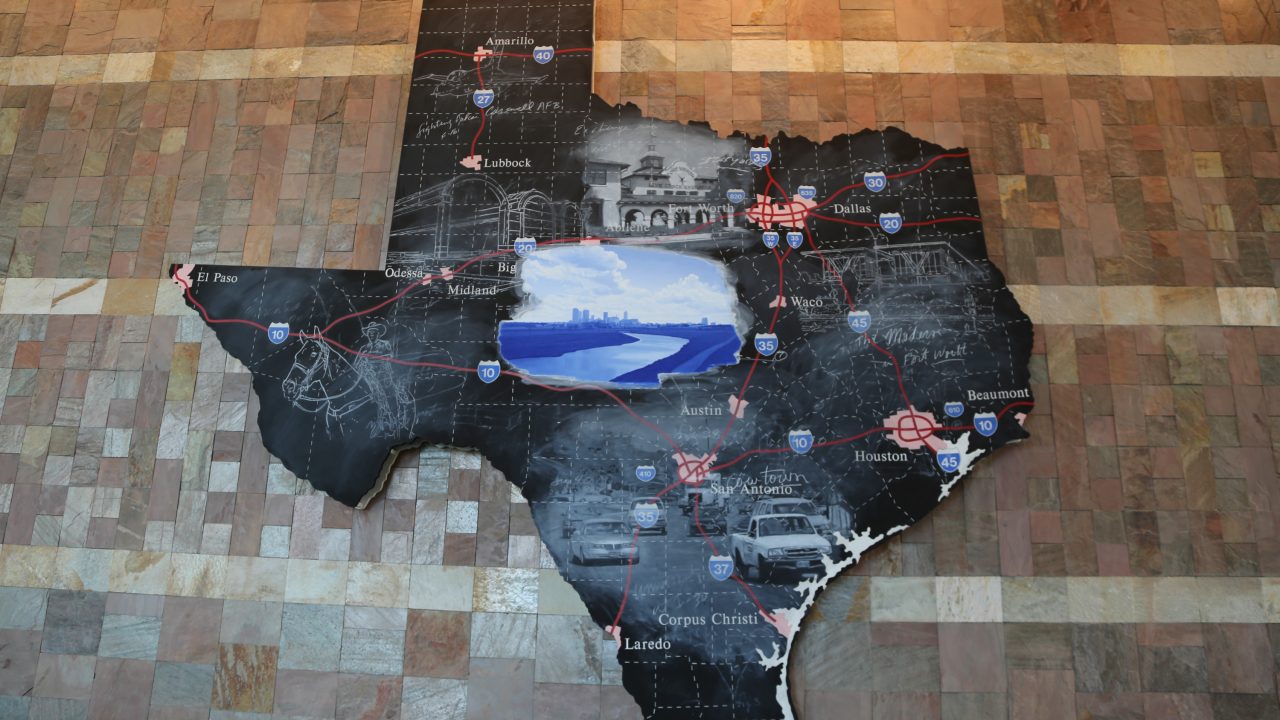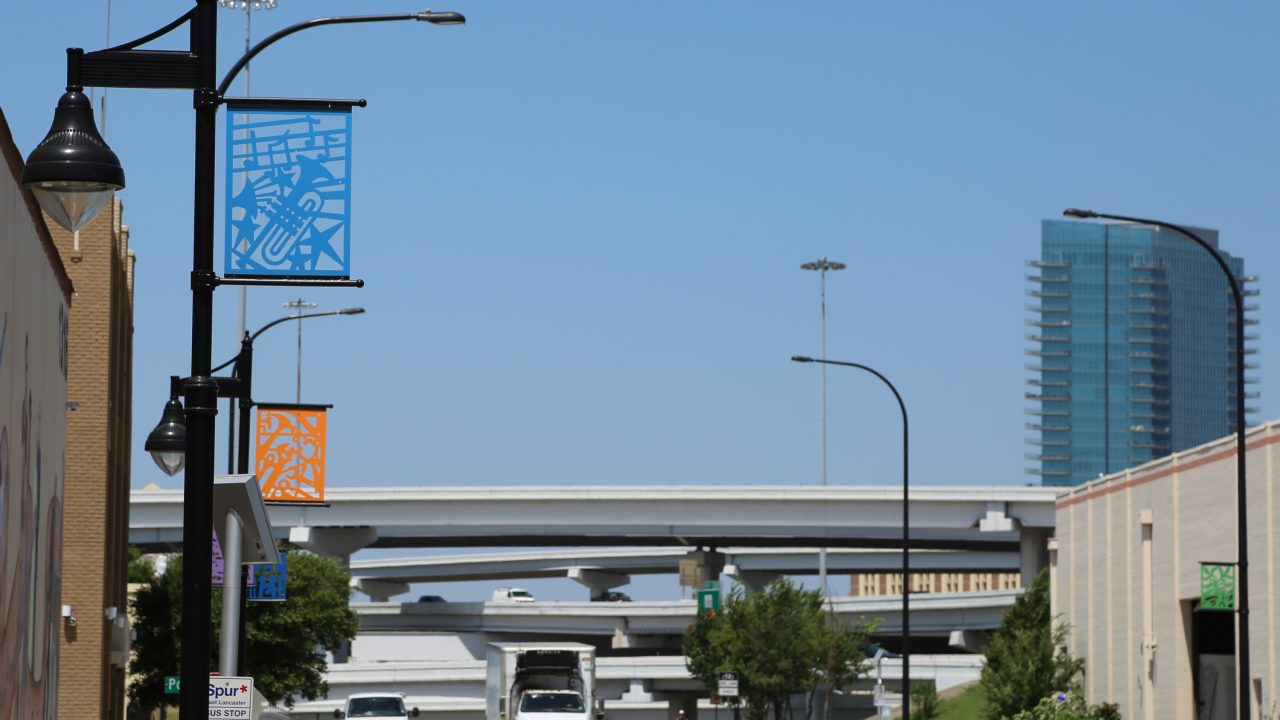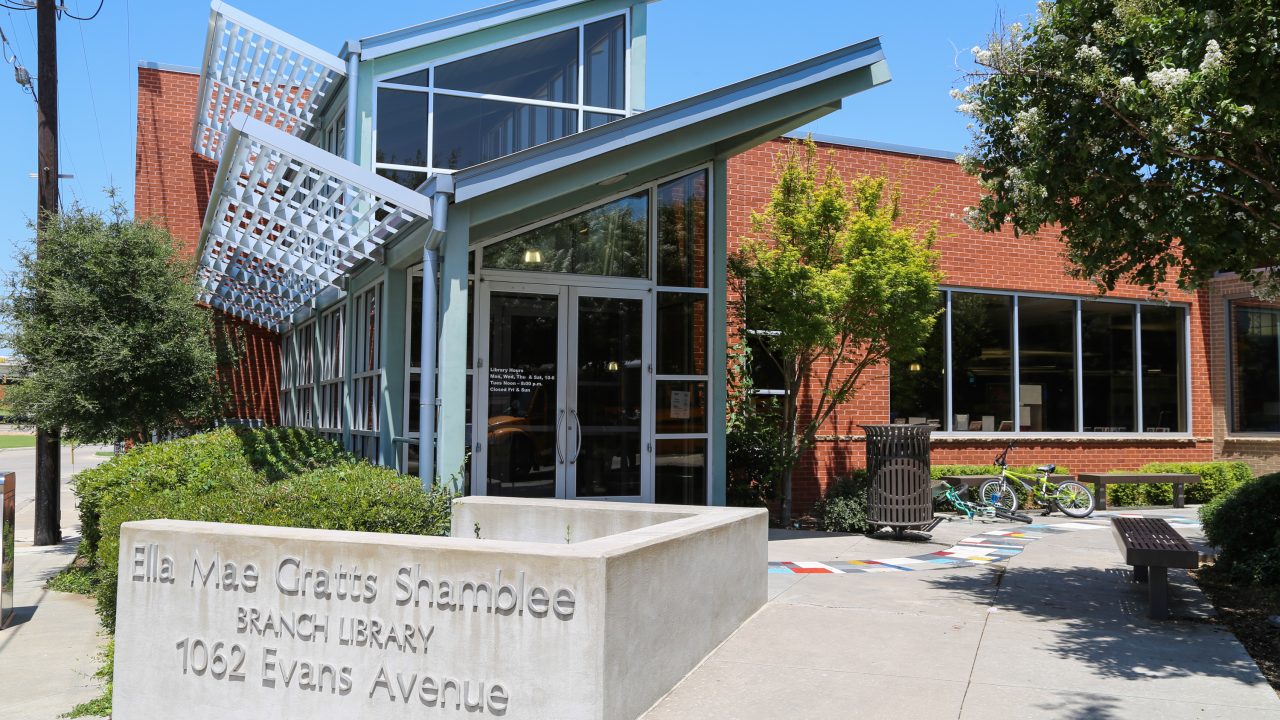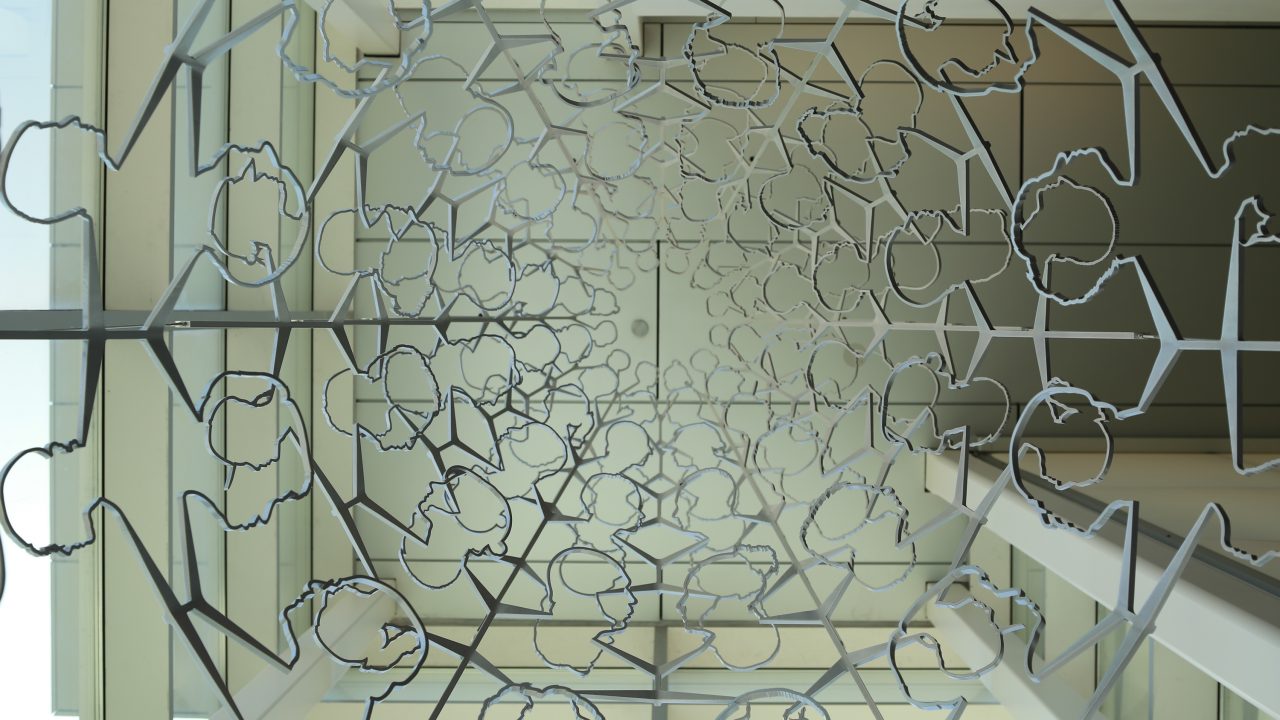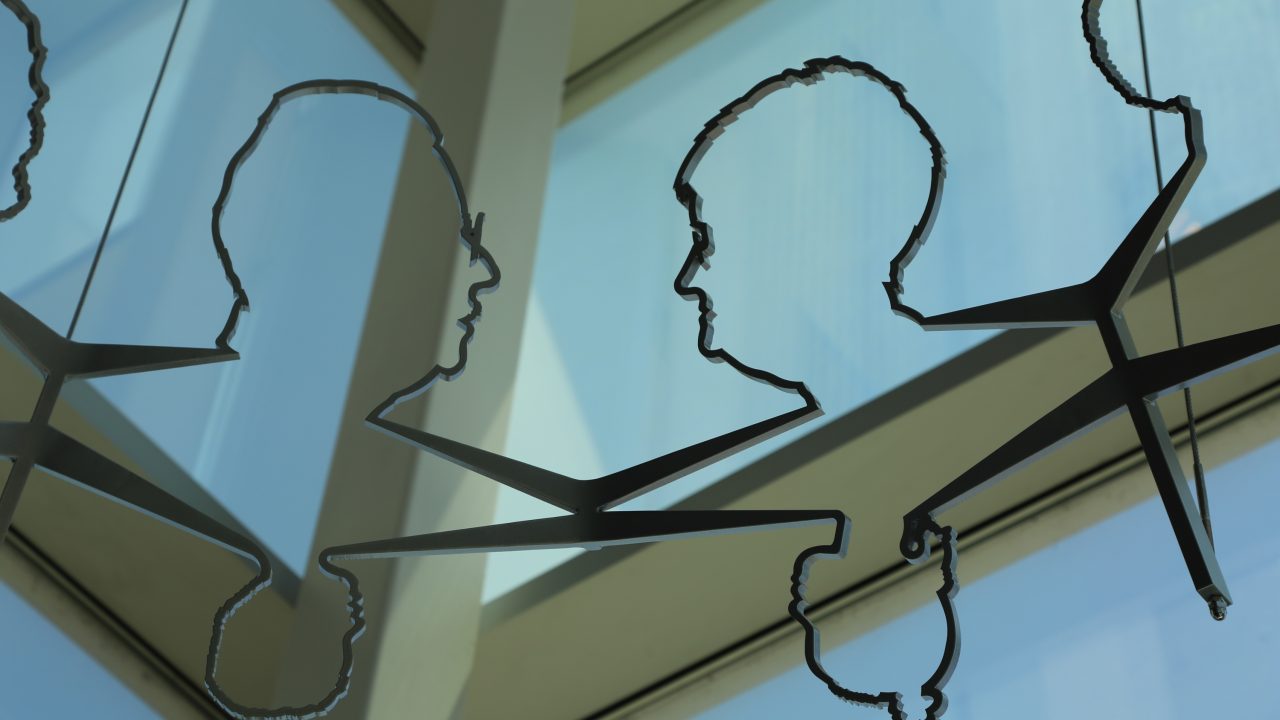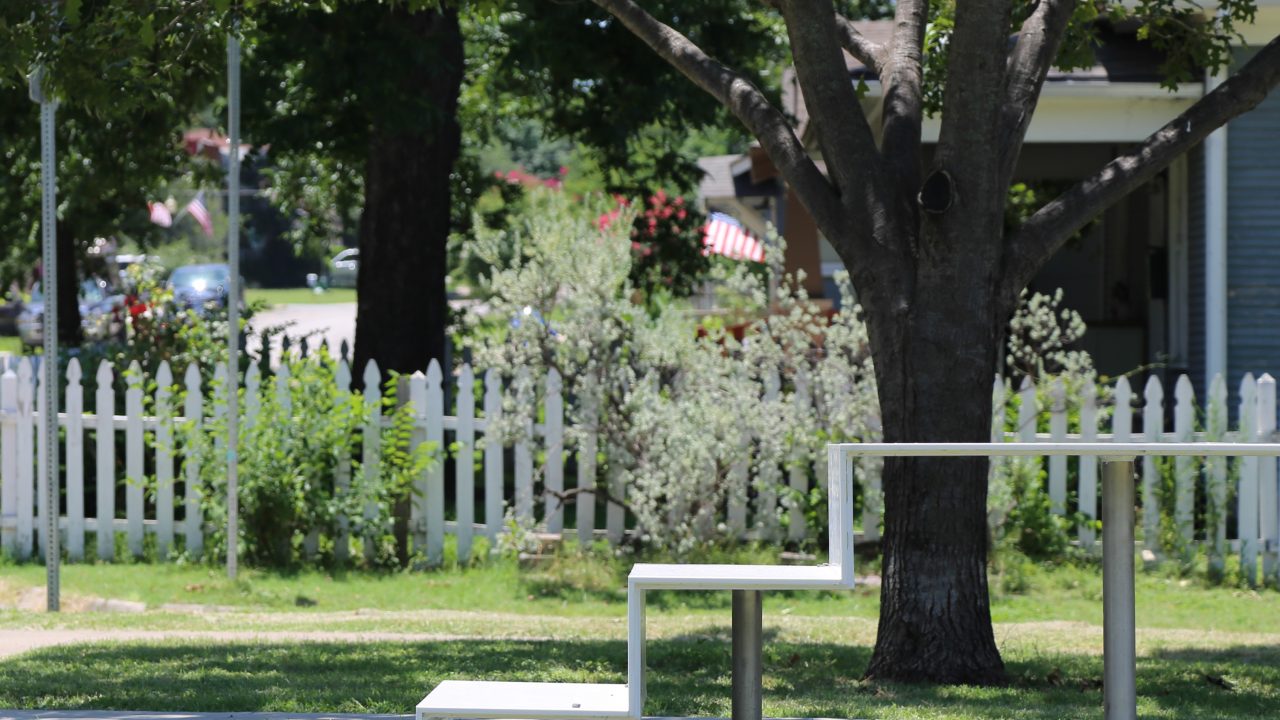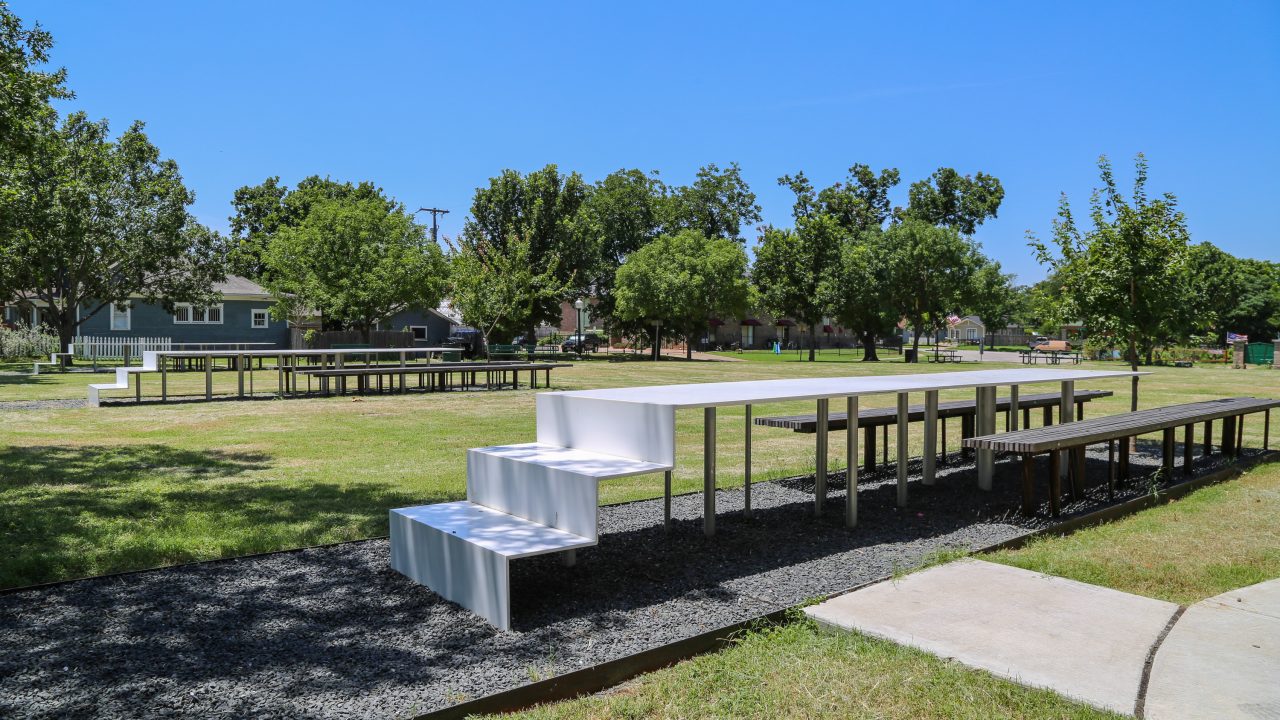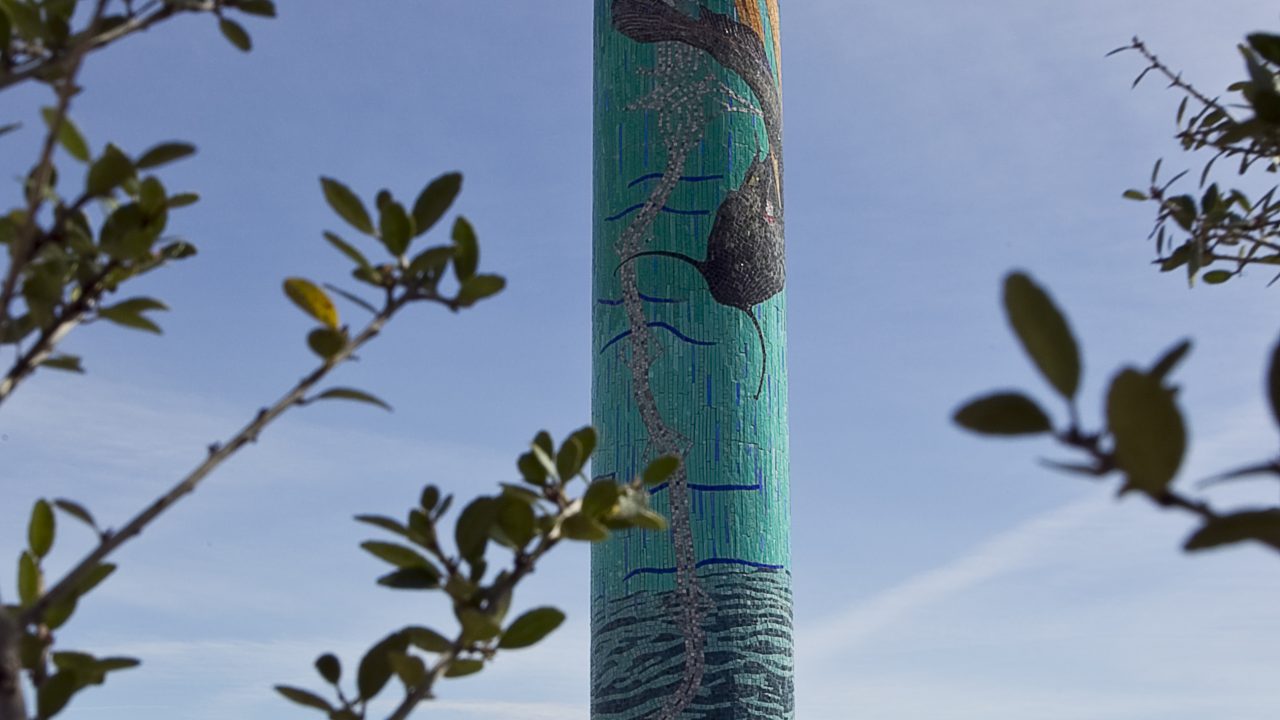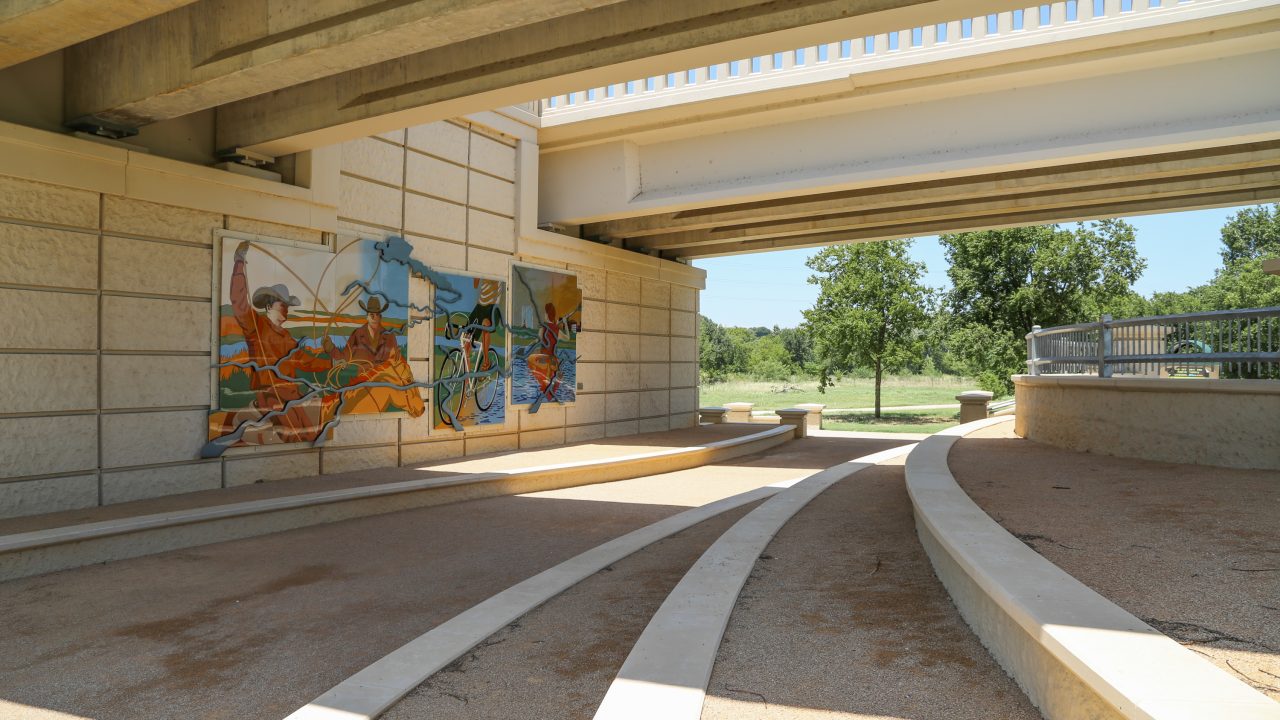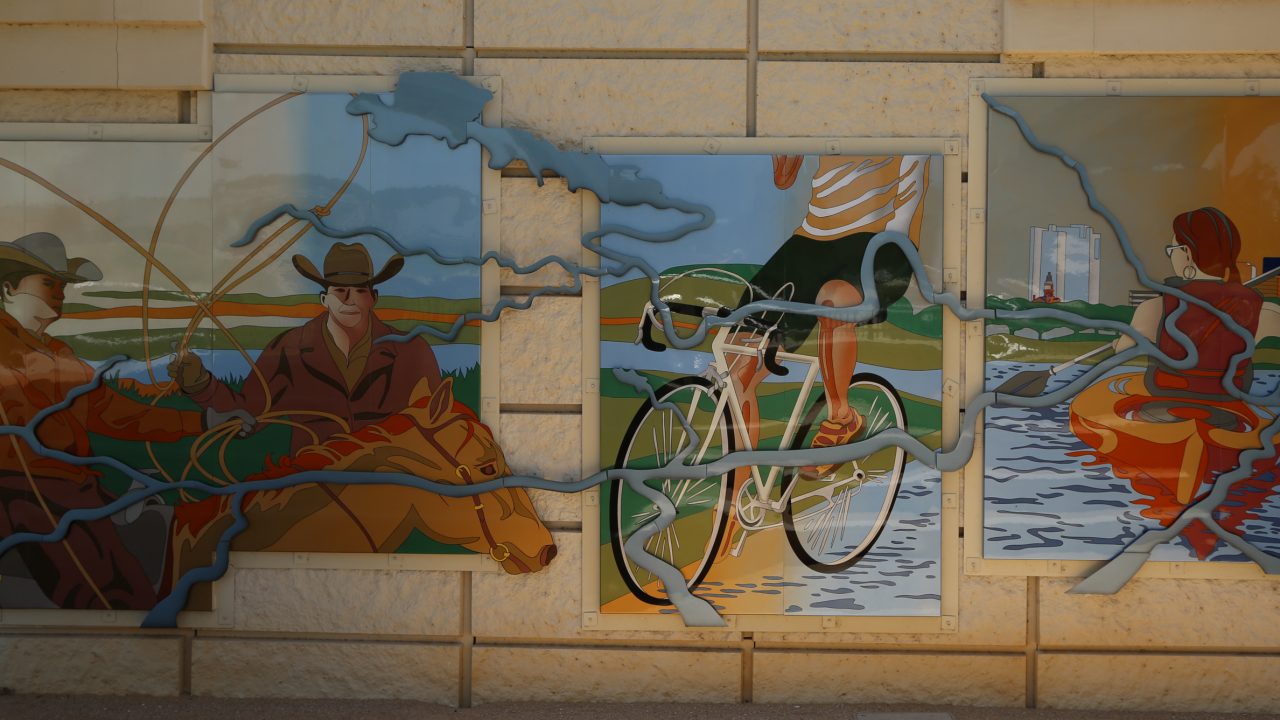A Tour Of Fort Worth’s Public Art
ArtandSeek.net August 1, 2016 97Fort Worth’s Cultural District is home to some of the region’s most prized masterpieces and cultural exhibits. But, whether you’re parking across the street from the Convention Center, jogging along the Trinity River or simply having lunch in Fairmount Park, you’re never very far away from art.
Art&Seek was curious about all of the eclectic art that filled the neighborhoods and streets of Fort Worth, so we reached out to Fort Worth Public Art, a program advised by the Fort Worth Art Commission and managed by the Arts Council of Fort Worth, and they connected us with Public Engagement Coordinator Kathleen Forrest.
Forrest took us on a tour of Fort Worth and told us about some of the art you’ve undoubtedly seen around Fort Worth.
Parking in Color
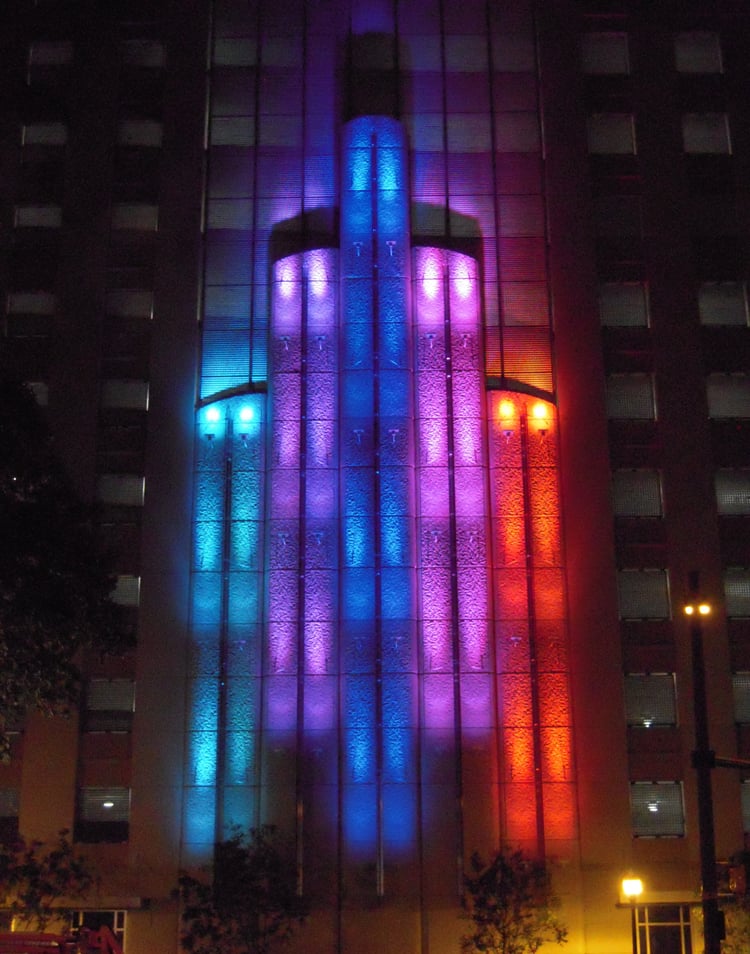
“Parking in Color” at night.
Photo: PhenomenArts, Inc.
If you’ve ever visited the Fort Worth Convention Center then there’s a pretty good chance that you’ve parked the in garage on 11th Street. What you may have missed during the search for the perfect parking spot, is that the Fort Worth Convention Center Parking Garage is pretty much a giant piece of public art!
Christopher Janney brought this parking garage to life through a combination of architecture, sculpture, and sound. Inside the garage, Janney has compiled sounds from Fort Worth’s past and present that play while you’re riding the elevators. These sounds replace the sounds of machinery normally heard on elevators and give riders a sense of place. On the garage exterior, Janney paid homage to the city’s historic Art Deco style with a glass chevron sculpture. When the sun sets, the glass lights up and the building becomes a beautiful nighttime landmark.
Intimate Apparel And Pearl Earrings
Donald Lipski is known for creating whimsical installations out of everyday objects. Check out the “cloud” he created out of thousands of hinged, enameled, stainless steel flaps for University of Texas, El Paso (link).
But, back when Lipski was creating his contribution to Fort Worth public art in the early 2000s, legend has it that he wanted to cover his hanging sculpture inside of the Fort Worth Convention Center with antlers.
The former mayor of Fort Worth, Mike Moncrief, had another idea. He thought cowboy hats were better suited to the look of “Cowtown.” So, the city threw a party and hundreds of people came out to donate their hats to art. There are more than 400 hats hanging from the piece. Each one has its own story and each is a favorite to somebody, thus the “Intimate Apparel” in the title.
The other half of the title is a reference to a woman from Fort Worth who volunteered her time to the project by helping the artist collect these hats. Her name is Garlene Parris, former trick rider and daughter of Cowgirl Hall of Famer Velda Tindall Smith. “Pearl Earrings” is an anagram of her name.
Early Texas/Modern Texas
As we venture into the 21st century, it can be easy to forget about the past.
Vernon Fisher’s pair of works “Early Texas/Modern Texas” that hang in the Fort Worth Convention Center help to remind us of how far we’ve come though. “Early Texas” presents early settlements, rivers, and native wildlife which are intertwined by tracings of the legendary cattle trails that helped define the economic vitality of 19th century Texas. “Modern Texas” focuses on urban life in the 20th century. Fisher replaces trails with highway systems and wildlife with modern landmarks.
JFK Tribute

The “JFK Tribute” by Lawrence Ludtke sits near the last spot that Kennedy addressed a general audience. Photo: Dane Walters
“No faint hearts in Fort Worth” said President John F. Kennedy on the morning of November 22, 1963.
The statement was made to a crowd standing in the cold rain outside of his hotel in hopes of hearing from President. No one expected that it would be one of the last times that they would hear the President speak, but sadly the impromptu speeches he gave in Fort Worth that morning were the last he ever gave.
To commemorate the speech and the night the Kennedys spent in Fort Worth, Lawrence Ludtke created a 8-foot-tall bronze statue in the likeness of JFK. It stands in General Worth Square, which at the time was the parking lot for Hotel Texas, where the Kennedys stayed.
Tabachin Ribbon
The “Tabachin Ribbon” is a 13-foot tall metal sculpture made to look like a ball of ribbon. The piece was created by Mexican artist Yvonne Domenge who was inspired by the Tabachin tree, a native tree of Mexico.
“Tabachin Ribbon” is one of six sculptures that Domenge created for a temporary Chicago exhibition with the intention of donating them to cities with significant public art collections.
The “Tabachin Ribbon” has five pieces that are bolted together and can be unbolted for transport. It is 13 feet in diameter and is estimated to weigh 8,000 pounds.
Wind Roundabout

“Wind Roundabout” by Ned Kahn is the first piece of public art in a developing area of Fort Worth. Photo: Dane Walters
With over 4,000 hinged aluminum plates, “Wind Roundabout” reveals the ever changing direction and force of the wind in Fort Worth.
The Ned Kahn creation is also the first sign of change at the center of Fort Worth’s ambitious Trinity River redevelopment project just north of downtown. The plan is to turn “Panther Island” into a San Antonio-style river walk on the newly created island between the Cultural District, the Stockyards and Downtown Fort Worth.
This monumental 30-foot tall sculpture rises up at the center of a traffic circle as a visual focal point. The dynamic veil of “flappers” reflects light from passing cars and buildings at night, while mirroring the sun and clouds as they move across the vast Texas sky during the day.
Avenue Tapestry
Not every piece of public art is as big as “Wind Roundabout.” Some are a lot smaller, but add just as much color and life to a particular location. A perfect example are 24 poster-sized sculptural panels along East Lancaster Avenue. These pieces are as colorful as the bustling activity in the neighborhood.
East Lancaster Avenue has a homeless population that migrates along it. But in his panels, Michael Pavlovsky decided to celebrate the people working in the neighborhood – at police stations, public transportation hubs, churches, and homeless shelters. Also, if you look closely, you can see renderings of native animals and plants scattered within the pieces.
35 City Blocks
The work of Letitia Huckaby has been influenced by traditional African American patchwork quilts, which you may have seen in our studio tour with her back in 2010. And that influence was shared with the people who frequent the Ella Mae Shamblee Public Library. The patchwork begins at the entrance of the library with a stone tile mosaic river that leads you into the building and guides you to a window with a quilt-like design.
Huckaby’s design combines contemporary portraits, historic photographs, and blocks of brightly colored glass that visually link the past to the present. When the light shines through, it is hard to not stare at the photos and think about the people who have grown up in Fort Worth, or on Evans Street, where the library is located. The photos of children keep you focused on the promise of tomorrow’s future.
Blue Lines
When Ralph Helmick decided to create an installation for the Polytechnic Heights Neighborhood Police Center a few years back, a few things inspired his creative process.
The first was William Shakespeare’s famous passage “The Seven Ages of Man.” This was significant because he wanted to bring everyone from the Polytechnic Heights neighborhood into the fold for this creation. Helmick wanted the old and the young to be represented.
The second inspiration came from the neighborhood. He wanted the community to be part of his work, so he took portraits of people and used their silhouettes in his artwork. You can see the faces (both young and old) in the seven-tiered installation that hangs inside the Police Center.
At night, the sculpture is illuminated in crisp blue, referencing the “thin blue line” and the role of the police within the greater community.
Memory: Fairmount Park
For folks in the historic Fairmount Park neighborhood, the porch has always been a place for socializing. Children use the porch as a “safe” place during a game of tag; adults meet to talk about community issues: the porch is important to the history of this community.
That significance wasn’t lost on Bart Shaw. Shaw heard community members say they wanted his work to reflect their history, so he created “Memory: Fairmount Park.”
These tables have steps like a porch and mirror the homes they sit in front of. But, unlike those homes these steps lead to maple trees at the end of the table. The maples are young and of different varieties, but the hope is that they’ll grow and eventually bring shade, which will make them perfect locations for socializing and for gathering.
Trinity Water Fowls/Water Crossing Markers
If you’ve driven on the Chisholm Trail Parkway then you’ve probably noticed the mosaics on the side of the highway. What you may not know is that these markers denote points where the parkway crosses streams and tributaries of the Trinity River. Norie Sato placed them there as reminders of the beautiful ecosystem that lives right next to the highway. Each marker has an image of an animal that lives in the water beneath and atop the marker is a sculpture of an item, like a bucket, that shows how people interact with water.
The images of animals were inspired by North Texas photographers.
Trailing the Trinity/Oxbow Traces
As you can tell, it’s pretty hard to throw a rock in Fort Worth without hitting one of more than 100 pieces of public art around the city. This is true even on the trail.
If you’ve ridden your bicycle on the pedestrian level of the Clearfork Main Street Bridge then there’s a pretty good chance that you’ve seen Devon Nowlin‘s “Trailing the Trinity” and Tommy Fitzpatrick‘s “Oxbow Traces.” Both pieces depict the importance of the Trinity River and the historic Edward’s Ranch.
“Trailing the Trinity” depicts the meandering the river and its many tributaries with images of life on the waterway during the past, the present and the future. The past is represented by ranchers moving cattle, the present is portrayed with a cyclist riding along trail and the future is represented by an individual kayaking the Trinity.
“Oxbow Traces” is a view of both natural and built environments on the historic Edward’s Ranch and Clear Fork Trinity. The mural shows us several moments at one time and through this piece we can view the channeling of the Trinity River, the growth of the modern landscape and the continued presence of “rural” lifestyle in Fort Worth.





